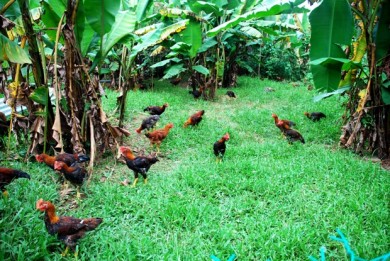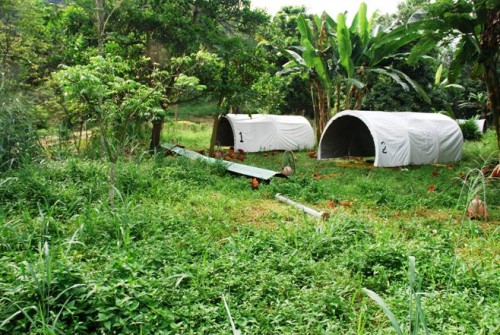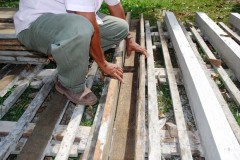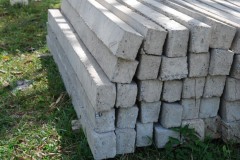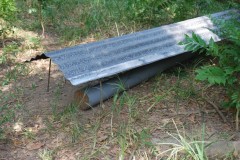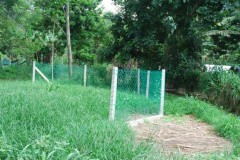Sep 10, 2011
Grass Fed Chickens - Some Basic Considerations
Choosing the right breed is important.
In the West, Cornish Crosses ( white feathered broilers) are free-ranged and pastured (grass fed).
In Malaysia, that's not possible. They will die from heat-stroke.
Many in Malaysia choose the Kabir ( a Sasso-type chicken) to free-range. Like the Cornish Crosses, the Kabir too, have very high metabolic rates and they will easily succumb to our mid-day sun without adequate shade and drinking water that is cooler than ambient.
Also, with their high metabolic rates, they need continuous feeding of high calorie feed. This defeats the purpose of pasturing as they will just sit around eating the feed pellets rather than forage. The omega 6: omega 3 ratio will be high, as they eat mainly the grain-based pellets. Health-wise to the consumer, it makes no difference whether these chickens are raised in a house or free-ranged. They will not and cannot be successfully grass fed. True grass fed chickens can never reach 2.5kg and above in weight. To grow to that size, they need a high calorie feed from grains and fats, which grasses cannot provide ( chickens are not cows and goats and cannot absorb the nutrients in grasses adequately like ruminants can).
Our tests have shown that Cornish Crosses and Kabir (Sasso) will have omega 6: omega 3 ratios as high as 40:1 and above if fed corn-based pellets ad-libitum even though raised on grass fields.
At our farm, we use mainly crosses from our traditional ayam kampung.
Ayam kampung will range whereas Cornish Crosses and Kabir will sit around
Providing sufficient space for the chickens to roam and for the land to recover fast is crucial. Our experience shows that we need a minimum of 25 sq ft of free roaming land for each chicken (factory farms provide 0.75 sq ft per chicken). Depending on the local conditions, this requirement may go up to as high as 50 sq ft of land per chicken. With sufficient space, the grasses can recover during the time the chickens are in the fields as we move them from one end of the field to the other.
So, two factors are involved here. One is the chickens must be moved along, and two the local soil conditions must allow the grasses to recover within the time that the chickens are in the field. In Malaysia we are lucky that our fields are easily 20 times more productive in terms of grass growth than many Western countries. The soil at our farm can count up to 60 to 100 earthworms per cubic feet. That's something Western farmers will die for!
Here are short clips taken from our hand phone. Note that the chickens are already market size and yet the fields are still green. In many farms when the chickens are at market size, the fields will be bare and smelly - that's perhaps one of the tests you as consumers can use to determine whether the chickens are truly grassfed.
Note how well these chickens make use of the space given to them by foraging and eating the grasses and plants.
10:13 Posted in Blog, Chickens | Permalink | Comments (0) | Tags: grass fed chicken, pastured chicken, free-range chicken, organic chicken, omega 6: omega 3 ratio, omega 3, dha, ayam kampung, cornish crosses, kabir, sasso
Jan 31, 2011
Starting Free Range Chickens in Malaysia
Fixed houses (reban) where the chickens come out to range and go back in at night is not a good solution to free-ranging slow growing breeds in our wet, humid climate. As the chickens can take up to 100 days to reach marketable size, the area around the house would be foul in no time.
The solution is a movable tent, and fenced fields to keep moving the chickens onto fresh grounds.
These are how the fields look like in our farm:
These are the steps:
1. Fence up the area:
To save costs, make your own concrete posts. If you don't know how, learn. It's a skill worth learning. Wooden posts in Malaysia means cutting of jungle trees, termite problems, wood rot, etc. Concrete the bottom of the fence to keep out pigs. You can lose up to 30 chickens per night from a small family of pigs.
2. Make your own field feeders and drinkers:
You can't be a farmer without basic bar-bending and welding skills.
3. Have a stationary seine-net like area for catching the chickens:
We generally can have an area up and running for 1000 chickens within 10 days - two hoop houses, 30 field feeders, water tank and self-made line drinkers, and fencing and posts for an area that's equal to half an acre ( the grass will last about 20 days, then you have to shift the chickens to the next field. If you don't, the chickens will start having health problems).
14:51 Posted in Chickens | Permalink | Comments (4) | Tags: hoop houses, pastured poultry system, free-range chicken, organic chicken, ayam kampung








